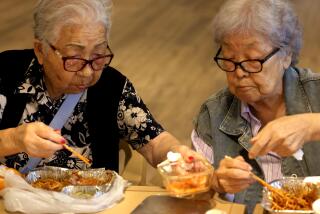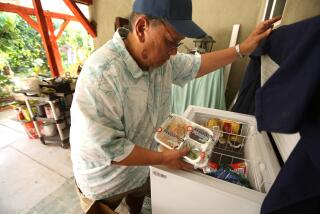Malnutrition Plagues Homebound Elderly
- Share via
NEW YORK — Ginevra Mattioli’s husband and closest friend are dead, her children live elsewhere and, at 89, she can’t get to the store on her own, much less prepare daily meals.
The hot chicken and rice lunch on her table was brought to her by volunteers.
“A body gets old. . . . I used to make lots of spaghetti. But now I can’t stand,” says the Italian immigrant. She touches a cut on her head from a recent fall, then mentions that she has lost five pounds in recent weeks.
Like many homebound elderly, Mattioli must rely on outsiders’ help to provide her food. But one group that offers such meals--the nonprofit Citymeals on Wheels USA--cautions that for a growing number who depend on the program, one delivered meal is simply not enough.
“Malnutrition among the elderly is a serious national epidemic,” said Marcia Stein, president of the New York-based group.
The problem has grown in part because people live longer; it’s being made worse by Americans’ mobility, which often leaves old people alone.
The concern is widespread. In North Carolina, for example, the Wake County Meals on Wheels estimates that 52% of its recipients are at risk of malnutrition. Most of those are 80 and older, said Vivien Keys, director of the county program.
In Rhode Island, 900 people receive the $4 to $5 meals daily while others are forced to wait more than a year to start getting them.
“It’s a major crisis. . . . We have 300-plus people waiting every week who are quite ill or terminally ill. And the problem is getting worse,” said Denise Martin, director of development at Rhode Island Meals on Wheels.
Nationwide, most of the 1 million meals delivered to homes daily are funded by government. In New York, the private sector provides about 37%, and Citymeals is trying to raise private donations in 20 cities to provide a second hot meal.
Currently, only the most at-risk people in a handful of cities--including New York, Miami and Buffalo--get a second meal. By contrast, 41% of American cities have waiting lists of elderly seeking home-delivered meals.
For many, isolation is compounded by poverty. Almost 40% of recipients of home-delivered meals are living below the poverty level, on $7,800 a year or less, Citymeals estimates. In New York, 60% of meal recipients live in poverty.
One of those people is Delores Rosenblatt-Groover, 65, whose severe arthritis keeps her in bed most of the time as she struggles to survive on $277 a month.
“I can’t afford to buy vegetables, fruits, desserts,” she said. “Sometimes I can’t get out of bed to prepare a meal.”
Wiping back tears, Rosenblatt-Groover, who is separated from her husband, explains that on the rare occasions someone takes her to the grocery she buys as much canned tuna and dry cereal as she can afford. “It’s depressing sometimes,” she said.
More to Read
Sign up for Essential California
The most important California stories and recommendations in your inbox every morning.
You may occasionally receive promotional content from the Los Angeles Times.










